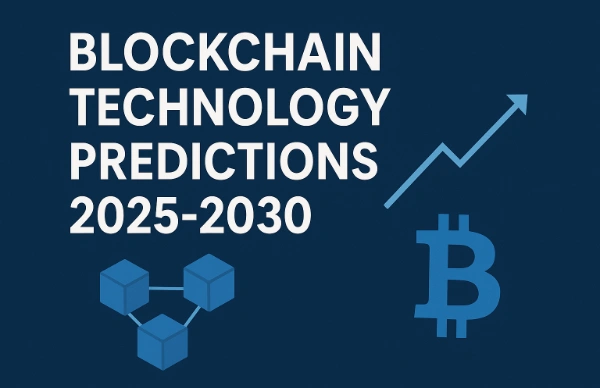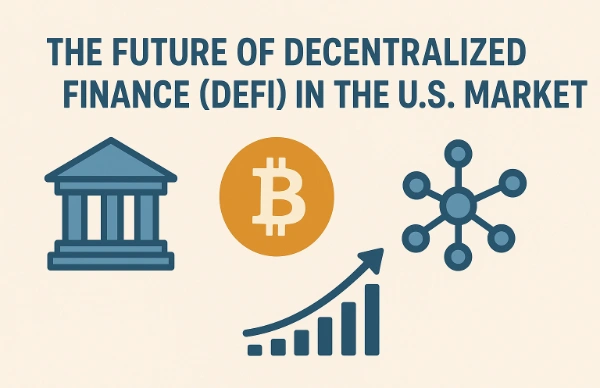The blockchain revolution is far from over. As we stand at the threshold of 2025, the distributed ledger technology that started with Bitcoin has evolved into a multi-trillion-dollar ecosystem reshaping everything from finance to supply chains. But where exactly is this industry headed, and what can we expect in the next five years?
This comprehensive analysis explores blockchain technology predictions for 2025-2030, examining market trends, emerging applications, regulatory developments, and the transformative impact on American businesses and consumers. Whether you’re an investor, entrepreneur, or simply curious about the future of digital technology, this guide provides the insights you need to understand blockchain’s trajectory.
Table of Contents
Current State of Blockchain Technology in 2025
Market Overview and Growth Trajectory
The global blockchain market has experienced unprecedented growth, reaching an estimated $163 billion in 2024. This represents a compound annual growth rate (CAGR) of over 68% since 2020, making blockchain one of the fastest-growing technology sectors in modern history.
| Year | Global Market Size | Growth Rate | Key Drivers |
|---|---|---|---|
| 2024 | $163 billion | 72% | Enterprise adoption, DeFi growth |
| 2025 | $280 billion | 71% | Regulatory clarity, institutional investment |
| 2026 | $470 billion | 68% | Web3 integration, supply chain solutions |
| 2027 | $750 billion | 60% | Central bank digital currencies (CBDCs) |
| 2028 | $1.1 trillion | 47% | Mainstream consumer applications |
| 2029 | $1.5 trillion | 36% | Industry standardization |
| 2030 | $2.0 trillion | 33% | Global infrastructure maturity |
Key Sectors Driving Adoption
Financial Services: Traditional banks and fintech companies are integrating blockchain for cross-border payments, trade finance, and digital asset custody. JPMorgan’s JPM Coin and Visa’s blockchain initiatives exemplify this trend.
Supply Chain Management: Companies like Walmart and Maersk use blockchain for food traceability and shipping logistics, improving transparency and reducing fraud.
Healthcare: Patient data management, drug traceability, and clinical trial integrity are emerging as major blockchain use cases in healthcare.
Real Estate: Property tokenization and smart contracts for real estate transactions are gaining traction, particularly in high-value markets like New York and California.
Also read: Top 10 ASX Shares That Outperformed the Australian Market in 2025
Blockchain Technology Predictions for 2025
1. Institutional Cryptocurrency Adoption Reaches Tipping Point
By 2025, we predict that over 60% of Fortune 500 companies will have some form of cryptocurrency or blockchain integration. This includes:
- Corporate Treasury Holdings: More companies following Tesla and MicroStrategy’s lead
- Payment Integration: Major retailers accepting cryptocurrency payments
- Blockchain-as-a-Service: Enterprise solutions from Amazon, Microsoft, and Google gaining widespread adoption
2. Regulatory Frameworks Solidify Globally
The regulatory landscape will achieve greater clarity, with:
- Federal Crypto Legislation: Comprehensive cryptocurrency regulation in the United States
- CBDC Development: The Federal Reserve advancing digital dollar pilots
- International Standards: G20 countries establishing unified blockchain governance frameworks
3. Web3 and Metaverse Integration Accelerates
The convergence of blockchain, virtual reality, and artificial intelligence will create new digital economies:
- Virtual Real Estate: Blockchain-based property ownership in virtual worlds
- Digital Identity: Decentralized identity solutions replacing traditional authentication
- Creator Economy: NFTs and tokenized content revolutionizing digital ownership
4. Sustainability Solutions Emerge
Environmental concerns drive innovation in:
- Proof-of-Stake Dominance: Energy-efficient consensus mechanisms becoming standard
- Carbon Credit Trading: Blockchain-based environmental asset markets
- Green Finance: Sustainable investment tracking through distributed ledgers
Long-Term Blockchain Predictions: 2026-2030

The Era of Blockchain Infrastructure Maturity
2026-2027: The Integration Phase
During this period, blockchain technology will move from experimental to essential infrastructure:
- Interoperability Solutions: Cross-chain protocols enabling seamless blockchain communication
- Scalability Breakthroughs: Layer 2 solutions processing millions of transactions per second
- Enterprise Standards: Industry-specific blockchain protocols becoming standardized
2028-2030: The Mainstream Adoption Phase
The final phase of this prediction period will see blockchain becoming invisible infrastructure:
- Embedded Technology: Blockchain integrated into everyday applications without user awareness
- Global Financial System: International payments and trade finance predominantly blockchain-based
- Decentralized Internet: Web3 platforms replacing traditional centralized services
Sector-Specific Predictions
Financial Services Transformation
Digital Banking Revolution: By 2030, traditional banking will be fundamentally transformed:
- DeFi Integration: Decentralized finance protocols integrated with traditional banking services
- Programmable Money: Smart contracts automating complex financial instruments
- Cross-Border Efficiency: International transfers completing in seconds rather than days
Supply Chain and Logistics
End-to-End Transparency: Complete supply chain visibility will become standard:
- Product Provenance: Every product’s journey from raw materials to consumer trackable on blockchain
- Automated Compliance: Smart contracts ensuring regulatory compliance throughout supply chains
- Sustainable Sourcing: Blockchain verification of environmental and ethical sourcing claims
Healthcare Innovation
Patient-Centric Data Management: Healthcare will be revolutionized through:
- Unified Health Records: Blockchain-based patient records accessible across all healthcare providers
- Drug Authentication: Pharmaceutical supply chains secured against counterfeiting
- Research Collaboration: Secure data sharing enabling breakthrough medical research
Market Predictions and Investment Opportunities
Emerging Investment Themes
Infrastructure Development: Companies building blockchain infrastructure will see significant growth:
- Node Operators: Services providing blockchain network infrastructure
- Developer Tools: Platforms simplifying blockchain application development
- Security Solutions: Cybersecurity services specialized for blockchain environments
Industry-Specific Applications: Vertical-focused blockchain solutions will dominate:
- RegTech: Regulatory compliance automation through blockchain
- PropTech: Real estate technology incorporating blockchain for property management
- EdTech: Educational credential verification and micro-learning tokens
Risk Assessment and Mitigation Strategies
While blockchain presents enormous opportunities, several risks require careful consideration:
Regulatory Risk: Changing regulations could impact blockchain adoption rates and business models.
Technology Risk: Scalability limitations and security vulnerabilities remain ongoing challenges.
Market Risk: Cryptocurrency volatility affects blockchain investment attractiveness.
Competition Risk: Rapid innovation means today’s leaders may not dominate tomorrow’s market.
Geographic Trends: Where Blockchain Will Thrive
United States: Innovation Hub
America is positioned to lead blockchain innovation through:
- Regulatory Leadership: Clear frameworks encouraging innovation while protecting consumers
- Capital Markets: Deep venture capital and public market funding for blockchain companies
- Technical Talent: World-class universities and tech companies driving blockchain research
- Enterprise Adoption: Large corporations with resources to implement blockchain solutions at scale
Also read: How to Analyze a Company Financials Before Buying Stocks in the USA
Regional Development Patterns
| Region | Strengths | Focus Areas | Growth Prediction |
|---|---|---|---|
| Silicon Valley | Technical innovation | Consumer applications, Web3 | 45% CAGR |
| New York | Financial services | DeFi, institutional adoption | 52% CAGR |
| Texas | Energy integration | Renewable energy, mining | 38% CAGR |
| Florida | Crypto-friendly regulation | Tourism, real estate | 41% CAGR |
Technology Evolution: What’s Coming Next
Next-Generation Blockchain Features
Quantum Resistance: As quantum computing advances, blockchain networks are developing quantum-resistant cryptography to maintain security.
AI Integration: Artificial intelligence and blockchain convergence will enable:
- Predictive Analytics: AI analyzing blockchain data for market insights
- Automated Governance: AI-driven decision-making in decentralized organizations
- Smart Contract Evolution: Self-improving contracts that learn from execution patterns
Improved User Experience: Blockchain applications will become as easy to use as traditional web applications through:
- Gasless Transactions: Meta-transactions eliminating user transaction fees
- Account Abstraction: Simplified wallet management and key recovery
- Natural Language Interfaces: Voice and chat-based blockchain interactions
Interoperability Breakthroughs
The future blockchain ecosystem will be seamlessly connected:
Cross-Chain Protocols: Technologies enabling different blockchains to communicate and transfer value efficiently.
Universal Standards: Industry-wide adoption of common protocols for blockchain interaction.
Blockchain Internet: A network of interconnected blockchains functioning as a unified system.
Challenges and Solutions Ahead
Scalability Solutions
Layer 2 Development: Second-layer solutions processing transactions off the main blockchain while maintaining security.
Sharding Implementation: Dividing blockchain networks into smaller, parallel chains to increase throughput.
Consensus Innovation: New consensus mechanisms balancing security, speed, and energy efficiency.
Privacy and Security Enhancements
Zero-Knowledge Proofs: Enabling private transactions while maintaining blockchain transparency.
Multi-Signature Evolution: Advanced signature schemes providing enhanced security for institutional users.
Decentralized Identity: Self-sovereign identity solutions protecting user privacy while enabling verification.
Also read: Top US Cryptocurrency Exchanges in 2025: Which One Is Best?
Industry Impact Assessment
Traditional Industry Disruption
Banking and Finance: Traditional financial institutions must adapt or risk obsolescence:
- Disintermediation: Blockchain reducing need for financial intermediaries
- New Revenue Models: Banks pivoting to blockchain-based services
- Competitive Pressure: Fintech startups challenging traditional banking
Insurance: Blockchain automation transforming insurance operations:
- Smart Claims: Automated claim processing through smart contracts
- Parametric Insurance: Weather and event-based automatic payouts
- Risk Assessment: Blockchain data improving actuarial models
Legal Services: Smart contracts automating legal processes:
- Contract Automation: Self-executing agreements reducing legal overhead
- Dispute Resolution: Blockchain-based arbitration systems
- Intellectual Property: Blockchain registration and protection of IP rights
Job Market Transformation
New Career Opportunities: Blockchain creating entirely new job categories:
- Blockchain Developers: High-demand programming specialists
- Smart Contract Auditors: Security experts reviewing blockchain code
- Tokenomics Designers: Economists designing blockchain incentive systems
- DeFi Analysts: Financial experts specializing in decentralized finance
Skill Requirements: Traditional roles requiring blockchain knowledge:
- Financial Analysts: Understanding cryptocurrency markets and DeFi protocols
- Supply Chain Managers: Implementing blockchain traceability systems
- Cybersecurity Experts: Protecting blockchain infrastructure and applications
Also read: Apple Stock Price Prediction 2026, 2027, 2030, 2040, 2050
Investment Strategies for the Blockchain Future

Portfolio Diversification Approaches
Technology Stack Investment: Investing across the blockchain technology stack:
- Infrastructure Layer: Blockchain platforms and protocols
- Application Layer: Decentralized applications and services
- User Interface Layer: Wallets, exchanges, and user-facing tools
Sector Diversification: Spreading investments across blockchain applications:
- DeFi Protocols: Decentralized finance applications
- NFT Marketplaces: Non-fungible token platforms and creators
- Enterprise Solutions: Business-focused blockchain applications
- Gaming and Metaverse: Blockchain-based virtual worlds and games
Risk Management Strategies
Due Diligence Frameworks: Evaluating blockchain investments requires specialized knowledge:
- Technical Assessment: Understanding the underlying technology and its limitations
- Market Analysis: Analyzing adoption potential and competitive landscape
- Regulatory Review: Assessing regulatory compliance and risk exposure
- Team Evaluation: Examining the experience and track record of project teams
Social and Economic Implications
Financial Inclusion
Blockchain technology is democratizing access to financial services:
Unbanked Populations: Providing financial services to people without traditional bank access.
Microfinance Evolution: Enabling peer-to-peer lending and micro-investment opportunities.
Remittance Transformation: Reducing costs and increasing speed of international money transfers.
Economic Models Transformation
Token Economies: New economic models based on digital tokens:
- Utility Tokens: Providing access to services and platforms
- Governance Tokens: Enabling democratic decision-making in decentralized organizations
- Security Tokens: Representing ownership in real-world assets
Decentralized Autonomous Organizations (DAOs): Blockchain-based organizations operating without traditional management structures.
Environmental Impact and Sustainability
Green Blockchain Initiatives
Energy Efficiency: Moving from energy-intensive mining to efficient consensus mechanisms:
- Proof-of-Stake: Reducing energy consumption by 99% compared to proof-of-work
- Renewable Energy: Mining operations powered by solar and wind energy
- Carbon Neutral Protocols: Blockchain networks achieving net-zero carbon emissions
Environmental Applications: Using blockchain to address climate change:
- Carbon Credits: Transparent and verifiable carbon offset trading
- Supply Chain Sustainability: Tracking environmental impact throughout product lifecycles
- Renewable Energy Trading: Peer-to-peer renewable energy markets
Global Competition and Leadership
International Blockchain Race
China’s Digital Yuan: Central bank digital currency challenging global payment systems.
European Union Regulation: Comprehensive blockchain regulation setting global standards.
Emerging Markets: Countries using blockchain to leapfrog traditional financial infrastructure.
American Competitive Advantages
Innovation Ecosystem: Silicon Valley’s combination of talent, capital, and risk-taking culture.
Capital Markets: Deep and liquid markets for blockchain companies and investments.
Regulatory Approach: Balanced regulation encouraging innovation while protecting consumers.
Educational Infrastructure: Universities producing blockchain researchers and developers.
Preparing for the Blockchain Future
Business Strategy Recommendations
Start Small, Think Big: Begin with pilot projects while developing comprehensive blockchain strategies.
Partner Strategically: Collaborate with blockchain specialists rather than building everything in-house.
Invest in Education: Train existing staff on blockchain concepts and applications.
Monitor Regulatory Changes: Stay informed about evolving blockchain regulations and compliance requirements.
Individual Preparation
Skill Development: Learning blockchain-related skills increases career opportunities:
- Programming: Solidity, Rust, and other blockchain programming languages
- Finance: Understanding cryptocurrency markets and DeFi protocols
- Legal: Blockchain regulation and smart contract law
- Business: Tokenomics and blockchain business models
Investment Education: Understanding blockchain investments requires specialized knowledge:
- Technical Analysis: Evaluating blockchain projects and their potential
- Risk Assessment: Understanding the unique risks of blockchain investments
- Portfolio Management: Balancing traditional and blockchain investments
Also read: Step-by-Step Guide for Beginners: How to Start Investing in the USA
Conclusion: Embracing the Blockchain Revolution
The blockchain predictions for 2025-2030 paint a picture of transformative change across industries, economies, and societies. This technology, which began as the foundation for Bitcoin, has evolved into a fundamental infrastructure for the digital economy.
Key takeaways for the next five years include:
Institutional Adoption: Large organizations will integrate blockchain into core operations, moving beyond experimental use cases.
Regulatory Clarity: Government frameworks will provide certainty for blockchain innovation and investment.
Technical Maturity: Scalability, interoperability, and user experience improvements will enable mainstream adoption.
Economic Transformation: New business models and economic structures will emerge based on blockchain technology.
Global Competition: Countries and regions will compete to become blockchain innovation leaders.
The blockchain revolution is not just about technology—it’s about reimagining how we organize economic activity, govern institutions, and interact in digital spaces. Organizations and individuals who understand and adapt to these changes will be best positioned to thrive in the blockchain-powered future.
As we look toward 2030, blockchain technology will likely become as ubiquitous and invisible as the internet is today. The question is not whether blockchain will transform our world, but how quickly and in what ways. By staying informed, preparing strategically, and remaining adaptable, we can navigate this transformation successfully and participate in creating a more transparent, efficient, and equitable digital economy.
FAQ
What is blockchain technology and why is it important?
Blockchain is a distributed ledger technology that maintains a continuously growing list of records, called blocks, which are linked and secured using cryptography. It’s important because it enables trustless, transparent, and immutable record-keeping without requiring a central authority. This has applications in finance, supply chain management, healthcare, and many other industries.
How will blockchain affect traditional banking?
Blockchain will transform traditional banking by enabling faster cross-border payments, reducing settlement times from days to minutes, and automating many processes through smart contracts. Banks will need to adapt by integrating blockchain technology, offering cryptocurrency services, and competing with decentralized finance (DeFi) protocols.
What are the biggest blockchain predictions for 2025?
Key predictions for 2025 include: 60% of Fortune 500 companies adopting blockchain, comprehensive cryptocurrency regulation in the US, mainstream Web3 and metaverse integration, widespread adoption of energy-efficient proof-of-stake consensus mechanisms, and the emergence of central bank digital currencies (CBDCs).
Is blockchain technology environmentally friendly?
Modern blockchain technology is becoming increasingly environmentally friendly. While early blockchain networks like Bitcoin consume significant energy, newer networks use proof-of-stake consensus mechanisms that reduce energy consumption by over 99%. Many blockchain projects are also focusing on carbon neutrality and supporting renewable energy initiatives.
What skills do I need to work in the blockchain industry?
Key skills for blockchain careers include programming languages like Solidity and Rust, understanding of cryptography and distributed systems, knowledge of finance and economics for DeFi applications, legal understanding of smart contracts and regulations, and business acumen for tokenomics and blockchain strategy.
Disclaimer: The information provided on CryptoStockHub.com is for educational and informational purposes only and should not be considered financial, investment, or trading advice. We are not financial advisors. Investing in stocks, ASX shares, blockchain, or cryptocurrencies is a high-risk endeavor, and it is essential to conduct your own research or consult a licensed financial advisor before making any investment decisions. Past performance is not an indication of future results.






